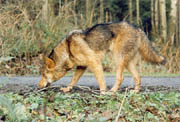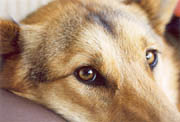
Smaller than the Grey Wolf, the Red Wolf (40-70 lbs.) is long-legged and slender with large ears. Larger than the coyote, the Red Wolf also has a wider nose pad, larger feet and coarser fur. The red wolf's coat is a mixture of cinnamon, tawny and gray or black in colour, while the back is normally blackish. The muzzle and limbs are tawny and the tail is tipped with black. An annual molt takes place in the summer.
The Red Wolf Has a longer, more slender skull than the Grey Wolf, and a more prominent sagittal crest (raised area of bone at the back of the skull used for anchoring the jaw muscles in larger carnivores). It's canine teeth are also longer and more slender. Dental formula is the same as in the coyote.
Red Wolf habitat includes swamps and other wetlands, forests and coastal prairies. Dens are often located in hollow trees, stream banks and sand knolls. Red wolves hunt alone or in small family packs. Their diet consists primarily of small mammals such as rodents, rabbits and hares but also includes insects, berries, grouse, feral pigs and white-tailed deer. Shy and secretive, the Red Wolf is primarily nocturnal.
Captive Red Wolves have lived for up to 14 years.
Formerly the range of red wolves extended across the southeastern United States, from central Texas to Florida, and at least as far north as Pennsylvania and Missouri. Three subspecies of the Red Wolf are recognized: the Florida (C. rufus floridianus) (extinct by 1930), Mississippi Valley (C. rufus gregoryi), and Texas red wolf (C. rufus rufus).
Considered a threat to livestock, Red Wolves were shot, trapped and poisoned as part of large-scale predator control programs throughout the early part of the 20th century. By the late 1930s, only two populations were believed to have remained; one in the Ozark/Quachita Mountain region of Arkansas, Oklahoma, and Missouri, and the other in southern Louisiana and southeastern Texas. Destruction of habitat from drainage of wetlands for farming and dam projects also contributed to the Red Wolf's demise. Deforestation in eastern Texas and Oklahoma also opened the coyote's range eastward. Reduced numbers of Red Wolves interbred with coyotes creating the threat of genetic introgression (diluting the genes of the species).
In 1962, Howard McCarley searched for several years in East Texas, and reported that, in his opinion, the Red Wolf no longer existed there. In 1965, John Paradiso reported that seven specimens taken in 1963-1964 near Anahuac (Chambers County), and one specimen taken in 1961 from Armstrong (Kenedy County), were definitely red wolves. Other specimens proved to be large coyotes.
The Red Wolf was added to the list of endangered species in 1967. By 1970, only a tiny population remained in a small area of woodland in far southeastern Texas and southwestern Louisiana.
In 1973, with the passing of the Endangered Species Act, the U.S. Fish and Wildlife Service established a captive breeding program. More than 400 wolf-like animals were captured in Texas and Louisiana over the next six years, but only 43 were considered Red Wolves and placed in a special facility at the Port Defiance Zoo & Aquarium in Tacoma, Washington. Genetic testing excluded another 26, and of the remaining 17, only 14 successfully bred in captivity.
In 1976, a pre-reintroduction site was set up on Bulls Island in the Cape Romain National Wildlife Refuge in South Carolina. By 1977, captive red wolf pairs produced their first litters. By 1980 the Red Wolf was considered extinct in the wild. In 1987, four pairs of red wolves were reintroduced to the wild on the 120,000-acre Alligator River National Wildlife Refuge in northeastern North Carolina, and the first wild reproduction occurred in 1988. By the mid 1990s, there were over 50 wolves inhabiting the refuge, at least 37 of which were wild born.
A second pack was reintroduced in the Great Smoky Mountains National Park in the Southern Appalachian Mountains in 1992 but there were problems with cattle depredation on nearby properties. Red Wolves were also released in the nearby Pocosin Lake National Wildlife Refuge in 1993. In 1998, the Great Smoky Mountain pack was relocated because of insufficient food supply.
There are now two more pre-reintroduction projects: Horn Island in the Gulf Islands National Seashore in Mississippi, and St. Vincent National Wildlife Refuge in Florida. Currently, 33 facilities in the U.S. are breeding captive Red Wolves. The Red Wolf population is estimated at between 270 and 300, 220 of which are in captivity.

There is some contention among taxonomists however that the Red Wolf, is not actually a separate species, but rather the result of crossing the Grey Wolf (Canis lupus) and the Coyote (Canis lanstrans). Like dogs and wolves, wolves and coyotes can breed, producing fertile hybrid offspring. A genetic study performed in 1992 was unable to find any significant differences between red wolves and known grey wolf/coyote hybrids. Whether or not the Red Wolf is a species or hybrid could determine the Red Wolf's future. Only animals which can be classified as true species are eligible for protection under the Endangered Species Act.
Fossil evidence suggests that red wolves have existed in North America 750,000 years ago. It has also been suggested that the Red Wolf is ancestral to the Grey Wolf.
References:
![[Previous]](../previous_off.gif)
![[Enlarge]](../enlarge_off.gif)
![[Next]](../next_off.gif)